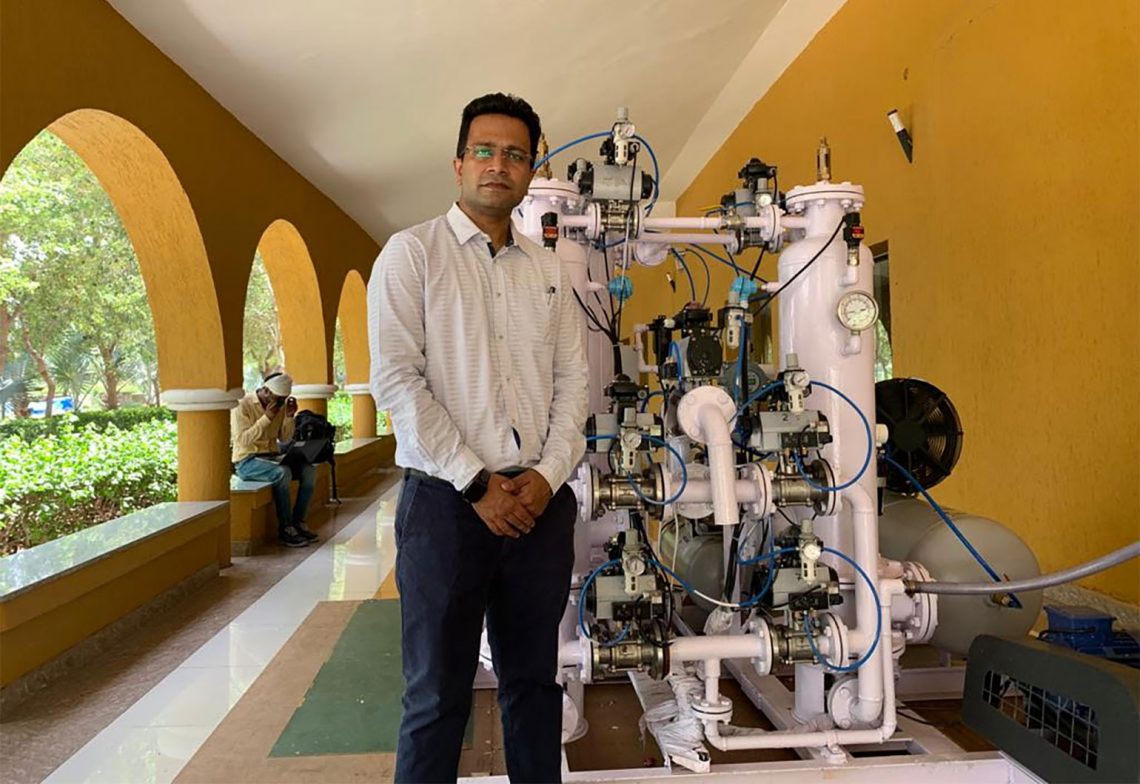After seeing heartbreaking footage of hospitals in India struggling to cope with COVID-19 cases, two Australian researchers decided to apply their knowledge to a simple, cheap way of helping sick people get oxygen.
Curtin University’s Dr Tejas Bhatelia and Monash University’s Professor Paul Webley, along with colleagues at Manipal University in Jaipur, India came up with the design for an oxygen unit that can be built from scratch. It is easily transportable, repairable, durable and can be run on a diesel generator.
Professor Webley told create that the researchers adapted the design to create something low cost and able to be built with components that could be readily obtained locally.
“I have many years of industrial and academic experience in gas separation technology and am therefore familiar with commercial designs for oxygen concentrators,” the chemical engineer explained.
The technology is based on the concept of a molecular sieve, which strips nitrogen from the atmosphere and produces oxygen on the spot.
“Molecular sieves are porous granular materials with molecule-size holes, which allow nitrogen from the air to enter and become trapped but do not allow oxygen,” Webley said.
“By exposing a container of these materials to air, the nitrogen is removed leaving pure oxygen behind.”
After a while, the molecular sieve becomes saturated with nitrogen and can no longer absorb any more, like a sponge that becomes saturated with water.
“At that point, we attach the container to a vacuum pump and pump out the nitrogen, regenerating the molecular sieve. Like squeezing a sponge to remove the water, it is now ready to re-absorb nitrogen from the air,” Webley said.
“By performing these sequential steps in multiple containers with switch valves, we can provide a continuous stream of enriched oxygen to a patient. This technology is called vacuum swing adsorption.”
The researchers have demonstrated that their oxygen conversion unit can produce oxygen for up to 20 to 30 patients, or can be used to refill oxygen cylinders.
So far, they have been able to achieve up to 70 per cent pure oxygen, and are working to increase that figure to 90 per cent in the near future.
An oxygen concentrator made for the pandemic
Webley explained that conventional oxygen supply for ventilators is in the form of liquid oxygen made by distilling liquefied air.
“This is made at large, centralised, industrial gas facilities and trucked to customer sites where the oxygen is stored in cryogenic vessels, vaporised and fed into gas distribution networks within the hospital, to each patient bed,” he said.
Oxygen is supplied in pressurised gas cylinders, which do not last long and need to be returned to centralised oxygen plants for refilling. For smaller or remote clinics, this presents logistical challenges.
“Personal oxygen concentrators based on vacuum swing adsorption are also available in the market, but they are unfortunately expensive, typically can only supply one patient, and need frequent servicing,” he added.
“In the current COVID crisis, there is a great shortage of these units globally. Our desire was to build slightly larger units, suitable for 8 to 10 patients, using cheaper, more readily available items. We sacrifice the performance of the units to gain a cheaper product, with a more rapid manufacturing timeline.”
Putting design in context
The effort was truly collaborative, with Professor Abhishek Sharma at Manipal University providing advice on the constraints on the design for an Indian context, such as what molecular sieves are available, what pumps and valves could be procured quickly, the requirements of the oxygen in villages, and so on.
“As an engineer attempting to help humanity, the most important lesson to be learned is to be prepared to adapt our designs to the local circumstances and to listen to the customer’s requirements,” Webley said.
“An adequate but imperfect design delivered quickly and cheaply is often better than an optimal, more efficient design which can be costly and time-consuming to design and develop.
“We must also be willing to sacrifice intellectual property desires — which take time and money — in favour of getting help to those in need quickly.”
Webley said that he and his colleagues were motivated by seeing the footage of devastation occurring around the world and felt a deep-seated desire to save lives.
“I am a human first and then an engineer,” he said.
“Oxygen is abundant in the atmosphere; everyone should be able to access it easily. My deep experience in air separation research, development and deployment, and my desire to use my engineering skills to help humanity — after all, what else are they good for — are perfectly combined in this cause.”




Anyone wishing to support this development in India can do so by contributing to this effort
https://gofund.me/daee3b85
All contributors in this article are aware of my effort and I am collaborating with them too.
Cheers
Ambarish